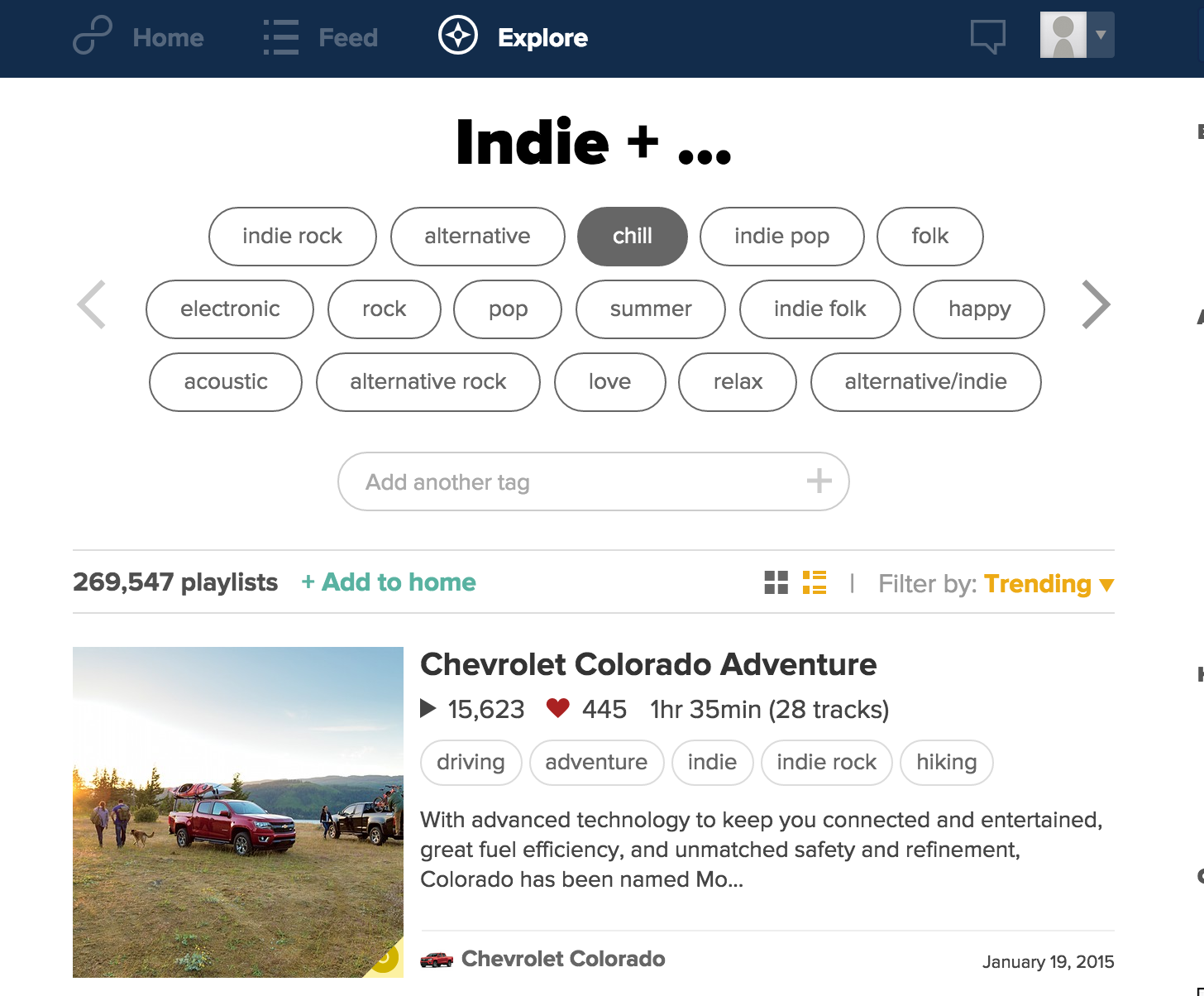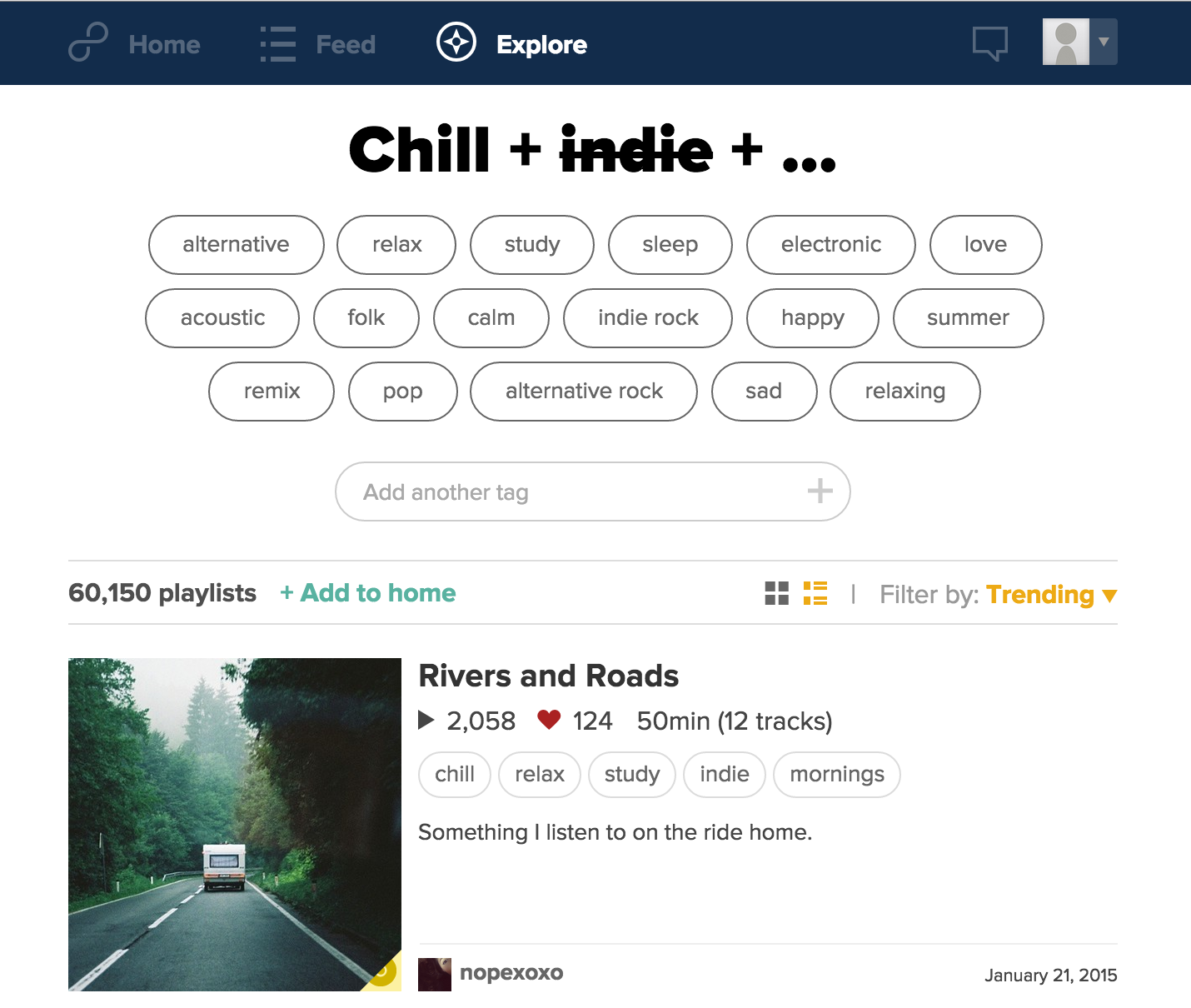Project Summary
8Tracks is a social platform that allows users to
curate their own playlists. While the platform has a nice mechanism of creating or listening to playlists, the unique feature about the website is the ability to discover these playlists. The platform allows the user to select a combination of three or less tags based on their mood, music genre or artist and presents the user with a series of playlists that comprise of those tags. Since the playlists are user created, the tags present on the playlists are also user-generated, which gives the entire concept of discovering music a more humane approach compared to traditional approaches of searching for tracks or playlists using text-based search.
While, I have always been amazed by the kind of music I get to hear on the 8Tracks platform, I was always interested in finding out that how well the platform is able to satisfy the music informational need of other users and how satisfied do the users feel listening to the music that comes up based on three or less tag choices of theirs. For this reason, I chose to study the user behavior of using 8Tracks while searching for music of their own interest.
Research Questions
While I have always been amazed by the kind of music I get to hear on the 8Tracks platform, I was always interested in finding out that how well the platform is able to satisfy the music informational need of other users and how satisfied do the users feel listening to the music that comes up based on three or less tag choices of theirs. For this reason, I chose to study the user behavior of while using 8Tracks for searching music. The questions I was trying to answer through this study are:
- How the use of tags selection for getting a list of music playlists influence the user's search experience when listening to online radio?
- Does prior knowledge about the tags make it even more convenient for users to perform the search process?
- Whether a use of tag-based methodology leads to lesser cognitive effort and allows user to focus more on the content retrieved than on the search process?
User Sampling
Sample Size |
Four users were recruited for this study
User Recruitment |
Users were recruited by email-communication and by word of mouth. A background questionnaire was given to all participants before the search tasks to get knowledge on their search capabilities and their affection towards music.
User Demoraphics |
The sample users comprised of participants that were regular online-radio listeners (30-50 hours / week) and of seldom online-radio users (4-6 hours / week). The user set also comprised of avid music listeners or musician and also occasional music listeners. One trait common among all users was that they have used an online music service for some time before.
Each user belonged to one of the four personas
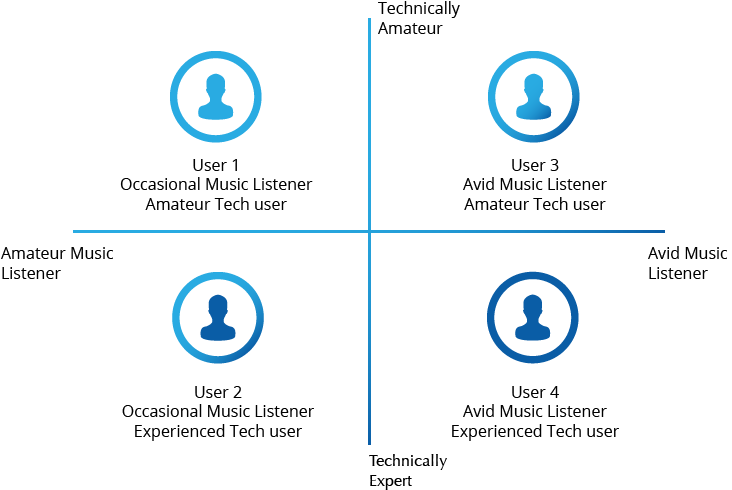
Criteria & Measurements
The aim of the study was to focus on the user’s experience over the system and not to measure the efficiency of the system to search for results. Efficiency was particularly not considered for this system because music search based on interests is a leisure activity and in this study I wanted to focus on the user’s experience without the time constraint.
Data was captured in four relevant areas to judge the user’s experience and their emotional reaction of using the platform.
Search Result
Effectiveness
Mental
Effort
User
Satisfaction
Emotional
Affect
User Tasks
The tasks were designed in a manner that allows the user to incorporate their own music interests in the task. They were specifically designed to incorporate users with different backgrounds and demographics and can also cater to users with different linguistic and musical preferences.Users were not given any particular artist or any theme so that the task can incorporate their favorite artist and music genres of their interest. The tasks were given in the same order to all the users as it would ensure that all the users are becoming familiar with the system in the same manner as they proceed from task I to task III. Hence, rotation of tasks was not applied for this particular study.
-
Task 1
Recollect your recent favorite music artist. Try to find songs that belong to that artist.
-
Task 2
Choose a particular language of music which you hear. Select or search that tag and select other tags based on your interests to find playlists of songs of your interest.
-
Task 3
You are hosting a family event for a celebration of your choice. You need to search music for a performance which you are doing along with friends or cousins. Search for relevant tracks for this performance.
Pilot Test Results
The aim of the study was to focus on the user’s experience over the system and not to measure the efficiency of the system to search for results. Efficiency was particularly not considered for this system because music search based on interests is a leisure activity and in this study I wanted to focus on the user’s experience without the time constraint.
Data was captured in four relevant areas to judge the user’s experience and their emotional reaction of using the platform.
Search Effectiveness Measures |
 All users reported a low effectiveness of the system wherein they did not feel that the songs that played in the playlist were very relevant to their search query. It was interesting to notice that most users reported a higher effectiveness for Task 2 compared to other tasks. This was probably due to the manner the task was designed, wherein they were asked to make a linguistic preference and then add tags to that based on their interests. In Task 1, all users reported a lower relevance rate because as part of the task they were asked to choose an individual artist of choice and they expected tracks to belong to only that artist whereas the playlist comprised of tracks of different artists with few songs from that particular artist.
All users reported a low effectiveness of the system wherein they did not feel that the songs that played in the playlist were very relevant to their search query. It was interesting to notice that most users reported a higher effectiveness for Task 2 compared to other tasks. This was probably due to the manner the task was designed, wherein they were asked to make a linguistic preference and then add tags to that based on their interests. In Task 1, all users reported a lower relevance rate because as part of the task they were asked to choose an individual artist of choice and they expected tracks to belong to only that artist whereas the playlist comprised of tracks of different artists with few songs from that particular artist.
Mental Effort Measures |
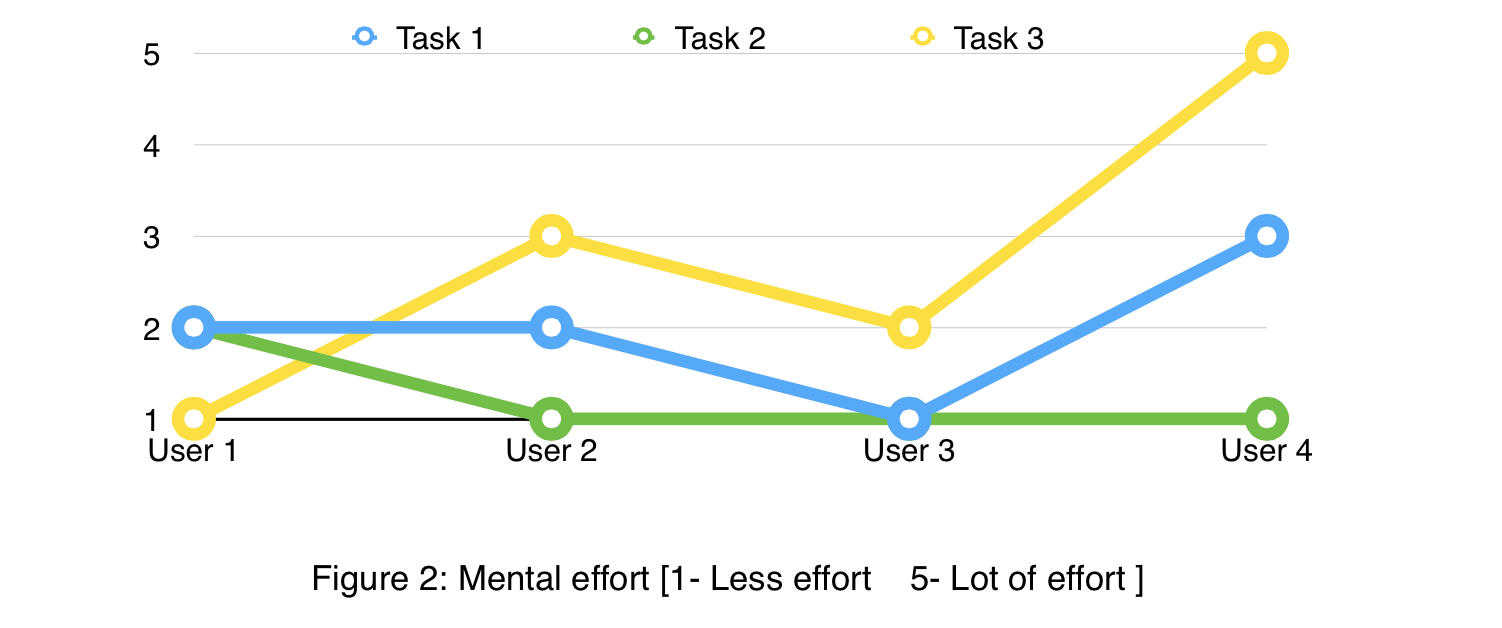 All users reported a low mental effort in using the system across the three tasks except User 4 who reported a very high mental effort in Task 1 and 3. The User 4 was an experienced musician and in case of Task 1 and 3, based on the tasks the user ended up choosing tags that were very specific and hence, the system was not able to reflect good results according to his preference. Hence, User 4 had to reformulate the query several times by using a different combination of tags each time.
All users reported a low mental effort in using the system across the three tasks except User 4 who reported a very high mental effort in Task 1 and 3. The User 4 was an experienced musician and in case of Task 1 and 3, based on the tasks the user ended up choosing tags that were very specific and hence, the system was not able to reflect good results according to his preference. Hence, User 4 had to reformulate the query several times by using a different combination of tags each time.
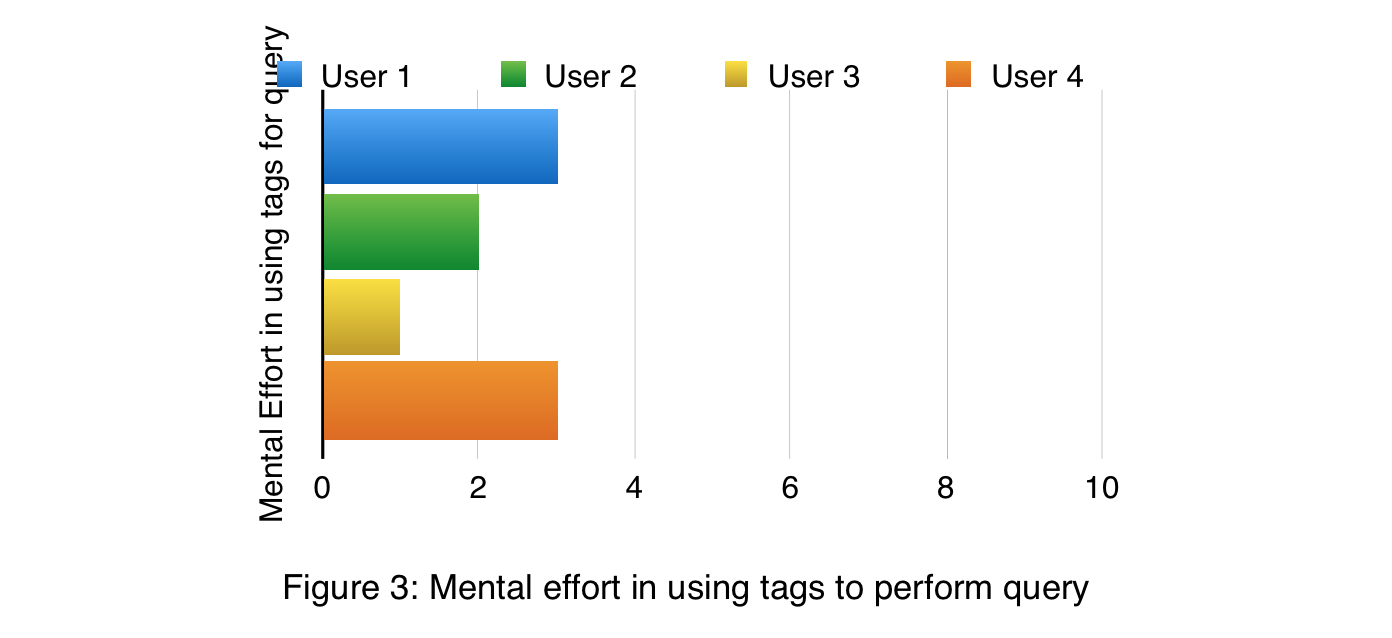 Also, in the post search questionnaire, User 1 and User 4 reported a higher mental effort in using tags to perform their query compared to other users. This was because User 1 was novice to internet radio systems and hence, found it difficult to select tags for the query while User 4 was an experienced musician and hence, ended up searching for tags that were very specific for the system to reflect relevant playlists with. Though all the users reported the mental effort to be very low over the 10-point scale.
Also, in the post search questionnaire, User 1 and User 4 reported a higher mental effort in using tags to perform their query compared to other users. This was because User 1 was novice to internet radio systems and hence, found it difficult to select tags for the query while User 4 was an experienced musician and hence, ended up searching for tags that were very specific for the system to reflect relevant playlists with. Though all the users reported the mental effort to be very low over the 10-point scale.
User Satisfaction Measures |
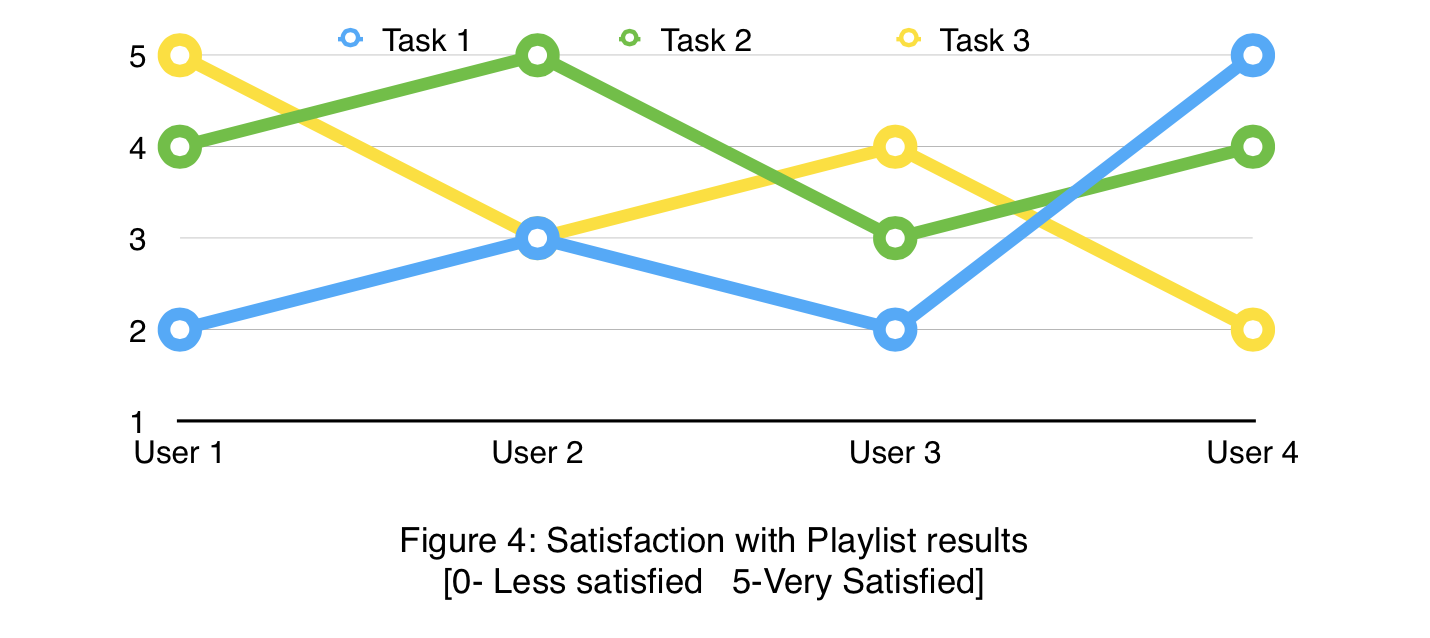 Although all the users reported a lower effectiveness of the system, all the users reported a higher value of their satisfaction with the results as they found the results interesting to listen to. The satisfaction increased further in tasks 2 and 3 for most users because in these tasks they had more freedom to combine several tags wherein in the first task they were confined to use tags that were related to the artist they had searched for.
Although all the users reported a lower effectiveness of the system, all the users reported a higher value of their satisfaction with the results as they found the results interesting to listen to. The satisfaction increased further in tasks 2 and 3 for most users because in these tasks they had more freedom to combine several tags wherein in the first task they were confined to use tags that were related to the artist they had searched for.
Also, in the post search questionnaire, all the users reported a high satisfaction in searching music over the system wherein all the users reported a score of 7 or 8 on a 10-point scale ranging from Less satisfied (0) to Very satisfied (10).
Affect(Emotion) Measures |
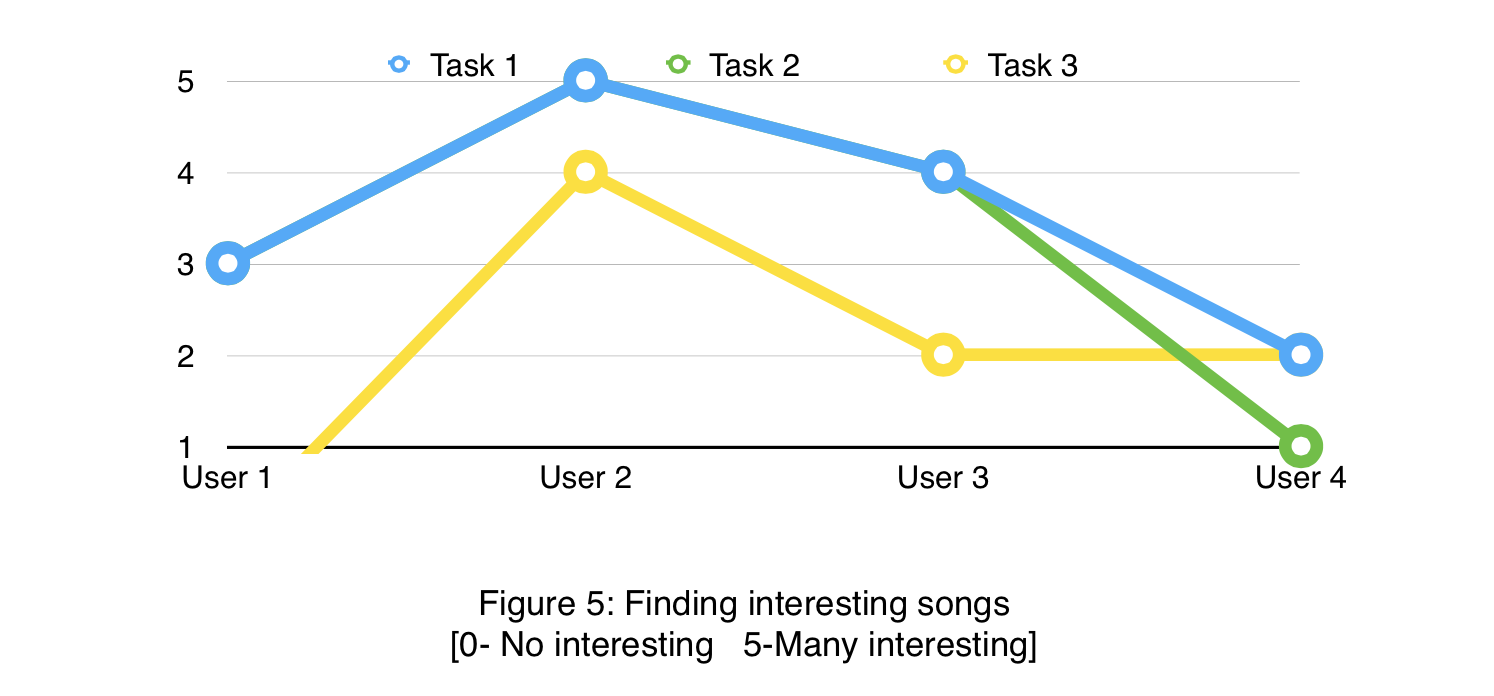 All the users in the study reported an average to high value on finding interesting songs in all the tasks except user 4. User 4 because of his high experience with music was looking for very specific songs in all his tasks and was extremely particular about his listening choices that made him disinterested with most of the songs.
All the users in the study reported an average to high value on finding interesting songs in all the tasks except user 4. User 4 because of his high experience with music was looking for very specific songs in all his tasks and was extremely particular about his listening choices that made him disinterested with most of the songs.
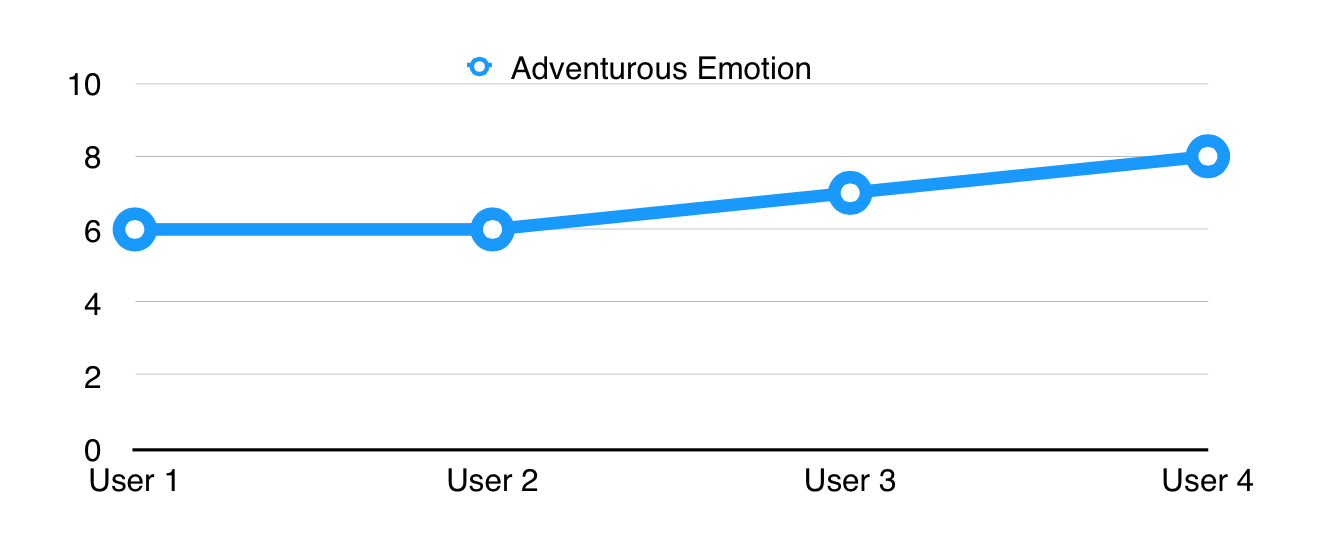 In the post-search questionnaire, all users reported a high score on the amount of adventurous emotion (Figure 6) they felt while exploring the different tracks across the system. It was interesting to see that though User 4 was disinterested with most of the songs he discovered, he reported the highest value of 8 on this factor, among all the users.
In the post-search questionnaire, all users reported a high score on the amount of adventurous emotion (Figure 6) they felt while exploring the different tracks across the system. It was interesting to see that though User 4 was disinterested with most of the songs he discovered, he reported the highest value of 8 on this factor, among all the users.
Conclusion
This pilot study revealed that most users were satisfied with using such a system based on the individual questionnaires and the exit interview. Most users felt adventurous while using the system and were happy about it’s approach. Most users confirmed that they would interested in using this system in future for their music interests during the exit interview. It was interesting to see that most users felt that the presence of three tags for their query was sufficient enough and they mostly ended up using two tags at maximum.
All users reported that such a system allowed them to focus more on the content than focusing on how they should search for content. It was also interesting to understand that most users felt that this approach of searching was not very different from text- based search because they use text-based search as a combination of keywords. Though, all users were little skeptical about the application of this technique to other domains like video-based systems and news systems, they felt that they see themselves using those systems in the future as well.
The results of the study are surely not at a quantifiable level to judge trends from it. The users showed varied behavior which made it difficult to understand that as a common trend in that category of users. More data collected by using a large set of users and a varied set of users, would surely offer more insights about the usage of such a system.

